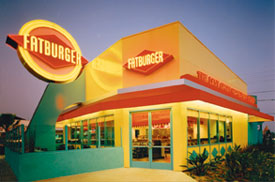If growing in a recession is tough, growing in a recession while emerging from bankruptcy is tougher still. Fatburger has done both, executing a turnaround strategy since it filed for bankruptcy protection in April 2009. Last year, the company landed squarely in positive territory, achieving double-digit unit growth and systemwide revenue gains of 4 percent. In its primary markets of California and Nevada, same-store sales rose more than 11 percent for the year, says Don Berchtold, president.
 As Fatburger worked to come out of bankruptcy, underperforming units were closed as were some in high-rent real estate. The store's footprint, which had inched up from 1,200 sq. ft. to almost 2,500 sq. ft. was brought back down. Old equipment was replaced and, working with suppliers, changes were made to the grill, the burger grind and format to improve speed of service. A veggie burger was added as was a Fat Salad Wedge. Interiors were spruced up and localized, with photos of XXXL (King Burger) Challenge winners adorning the walls. Menu boards were updated and burger options renamed and simplified.
As Fatburger worked to come out of bankruptcy, underperforming units were closed as were some in high-rent real estate. The store's footprint, which had inched up from 1,200 sq. ft. to almost 2,500 sq. ft. was brought back down. Old equipment was replaced and, working with suppliers, changes were made to the grill, the burger grind and format to improve speed of service. A veggie burger was added as was a Fat Salad Wedge. Interiors were spruced up and localized, with photos of XXXL (King Burger) Challenge winners adorning the walls. Menu boards were updated and burger options renamed and simplified.
All but three company-owned stores were sold to franchisees, with the ideal being "conversions" — local independents who buy into the brand and convert their operations to Fatburgers. That profile jives with a new management strategy that encourages franchisees and managers to take ownership, participate in their local communities and operate like entrepreneurs. "We don't just tell them what to do, we teach them how to do it and why it's important," Berchtold says. "We didn't chase trends and make big menu changes. We tightened everything up and focused in hard on our attitude, our people and our service."
Fast Facts
- Year founded: 1952
- Headquarters: Beverly Hills, Calif.
- Menu specialties: Beef burgers custom made to guests' tastes
- Service Model: Quick service, fast-casual
- Units: 105
- 2010 Sales: $78 million
- 2010 Growth: Revenue grew by 4 percent, units grew by 18 percent
- Projected 2011 growth: 25 units to open in 2011
- Key expansion markets: South Korea, Dubai, Lebanon, Saudi Arabia
- Typical location: Freestanding, mall, food court, drive-through
- Average unit size: 1,600–2,200 sq. ft.; 45–50 seats
- Average kitchen space: 35 percent to 40 percent of total square footage
- Average covers per day per unit: 250
- Average check: $11.26
- Total equipment investment per unit: $125,000
- Total unit cost: $450,000
Key Players
- Chairman: Andrew Wiederhorn
- President: Don Berchtold
- Vice President, Construction & Facilities: Bentley Hetrick
- Smallwares & Equipment: TriMark SS Kemp, TriMark RobertClark, Concept Services
- Food Distributors: Sysco Corp. and U.S. Foodservice
- Design: Robert Lee
- Purchasing: Procurement Plus



